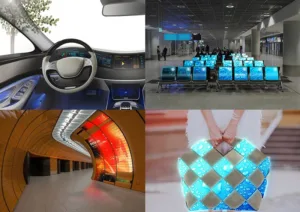FlexEnable, the leader in the development and industrialisation of flexible organic electronics, has developed a 12.1” glass-free, conformable organic liquid crystal display (OLCD) marking an important milestone in the commersialisation of large area flexible displays. The technology is compatible with existing LCD production lines, and is scalable to even larger area displays to meet the immediate market needs for applications including automotive, consumer electronics, and digital signage.
FlexEnable’s OLCD platform brings vivid colour and smooth video content to flexible displays, and is completely free of glass; instead, it uses organic transistors on a plastic sheet, making the display four times thinner (less than 0.3 mm) and more than ten times lighter than conventional glass-based displays. These characteristics, combined with the OLCD’s robustness and ability to conform to small and large surfaces, bring unique benefits to products and unlock design freedom that is not possible with glass displays. FlexEnable is already supplying small and large area display prototypes to strategic partners for integration into the next generation of products. FlexEnable has already demonstrated plastic LCD displays with radius-of-curvature below 3cm, causing these partners to rethink where and how LCD displays can be used.
In parallel, FlexEnable is working with Asian display manufacturers to support the transfer of its OLCD platform into conventional flat panel display (FPD) lines, enabling a full range of plastic LCD display shapes and sizes. Due to the use of low-cost plastics and the low-temperature manufacturing process (below 100°C), FlexEnable’s technology is the lowest cost flexible display technology available today.
Chuck Milligan, CEO of FlexEnable, said: “With the development of the 12.1” display we have proven the scalability of our OLCD technology. While LCD is the dominant and trusted display technology in the market today, glass-based LCDs can’t deliver the conformability, robustness and thinness requirements in new applications we are seeing across many sectors including automotive, consumer electronics and wearables.
“The capability to create flexible plastic LCDs on small and large areas enables us to address these market opportunities and to work with end-user companies on product prototypes, while simultaneously putting the supply chain in place for the mass manufacture of plastic LCDs. For end-user companies, this means that they can specify a wide range of flexible display sizes and shapes to create product designs not possible with glass-based displays.”
FlexEnable will show a 12.1” OLCD prototype in the Printed Electronics Applied in Automotive conference track at CES 2017 on 6 January 2017 at 14:15- 15:15 in LVCC, North Hall, N264 .

